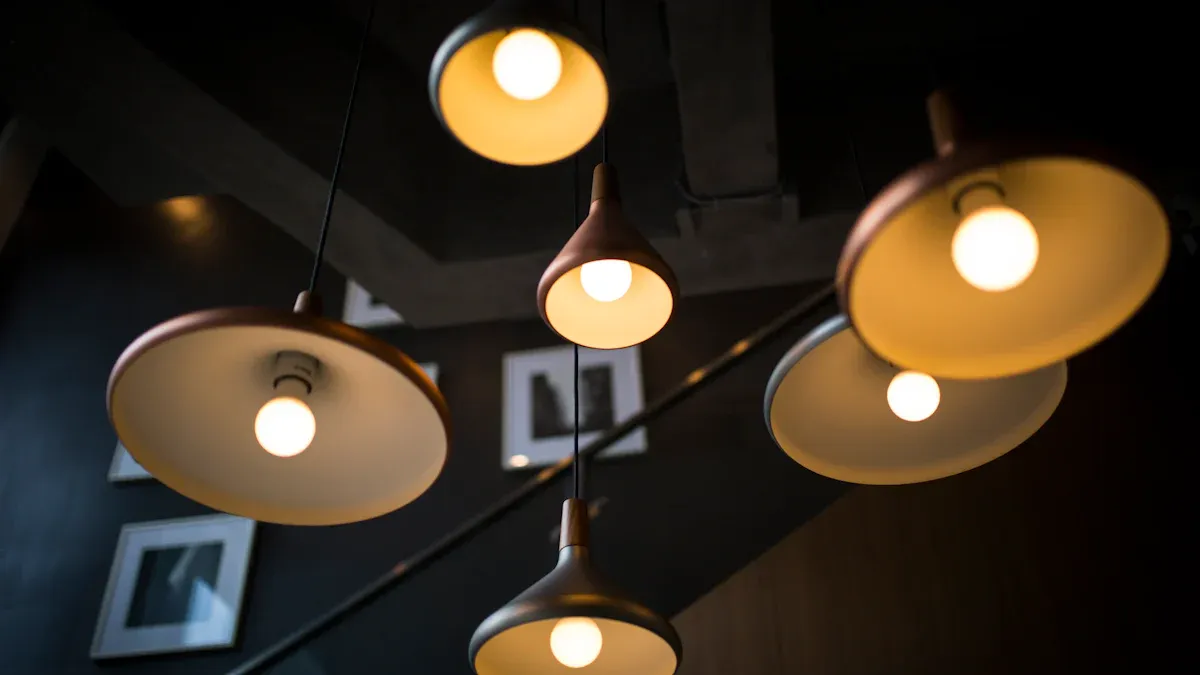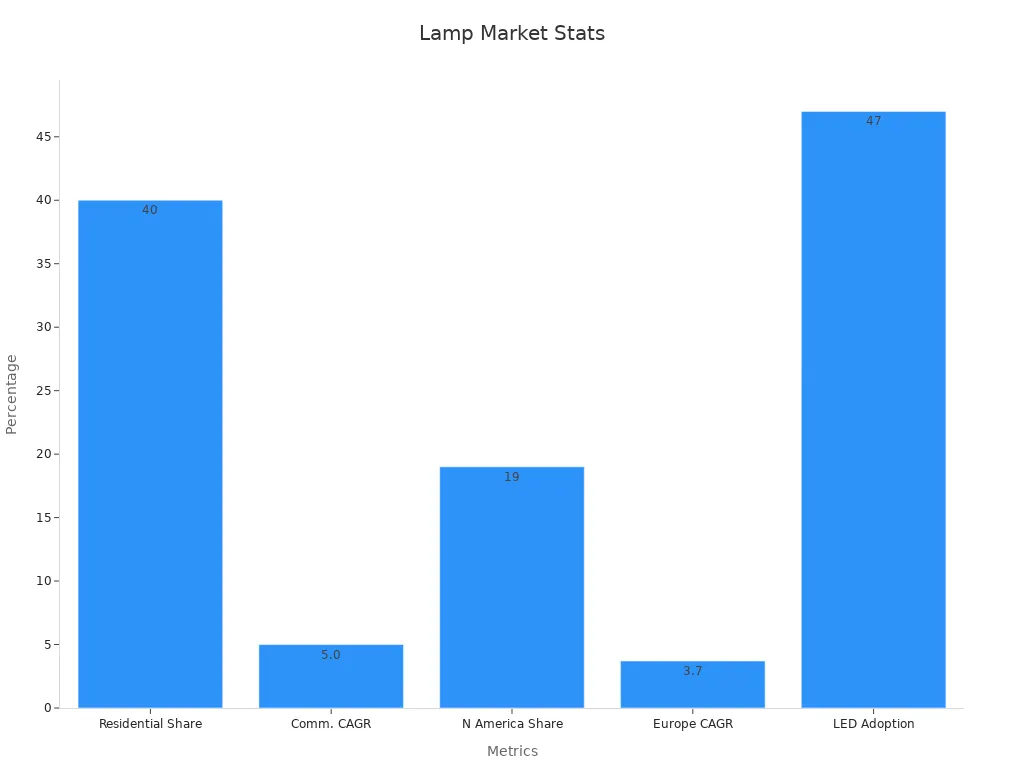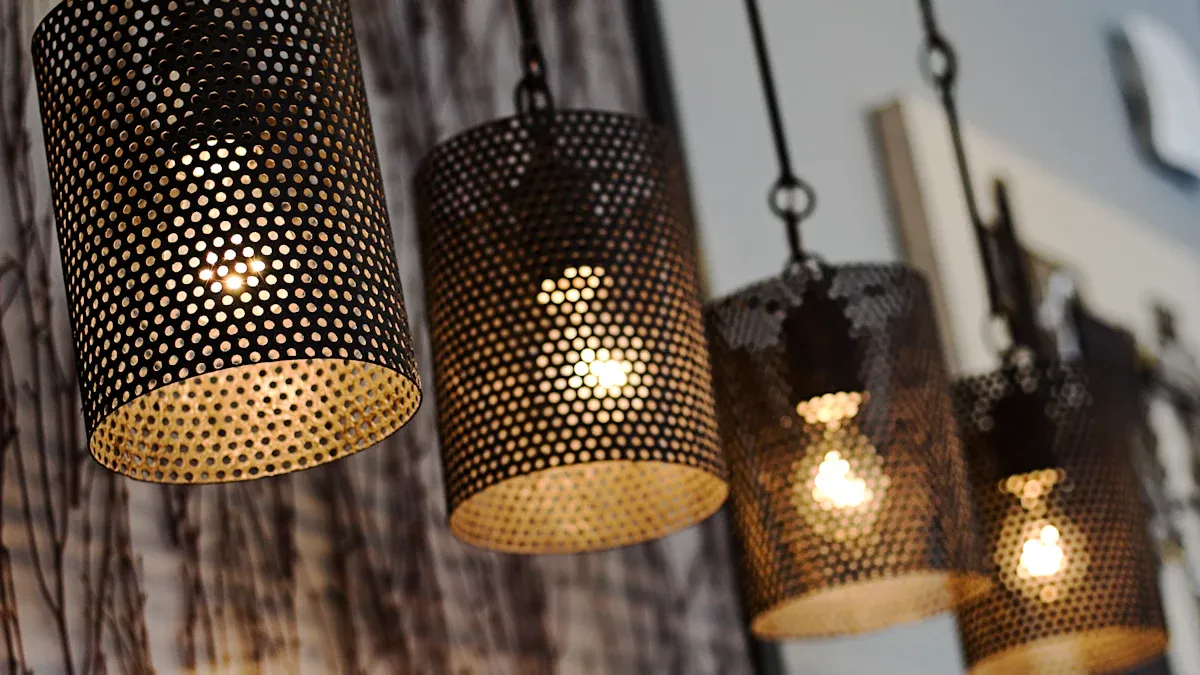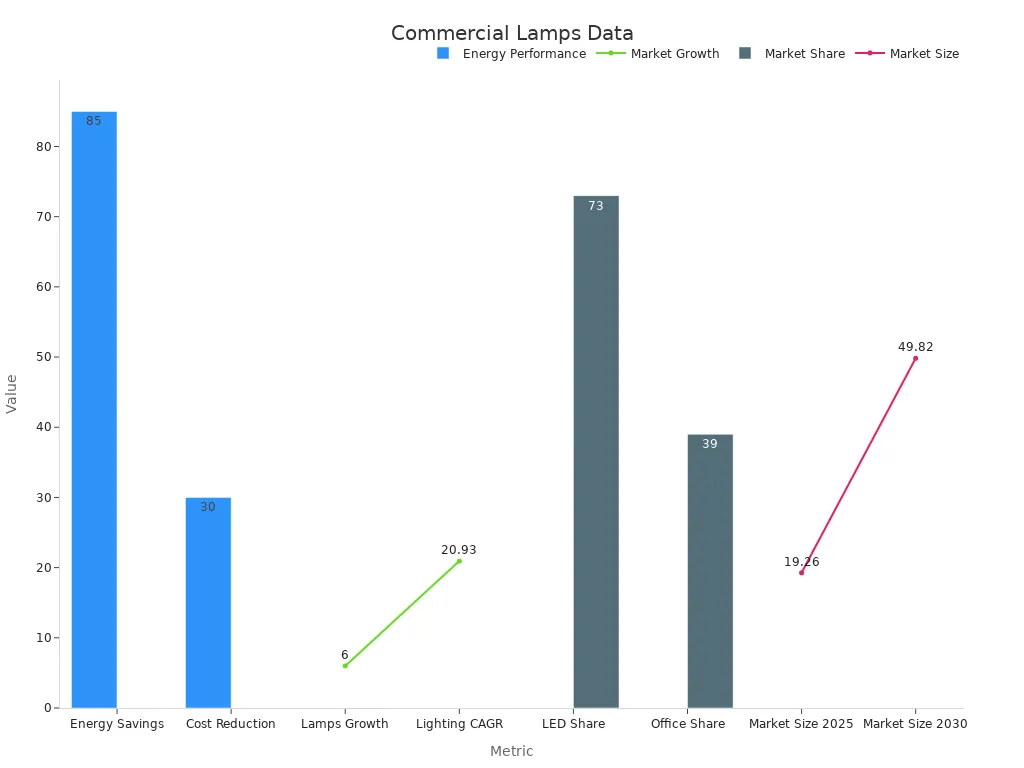Architectural Lamps: Design, Function, and Installation for Modern Spaces

You can change any room with architectural lamps and good lighting. These lamps are important for both how a space works and looks, especially in modern homes. When you pick the right lighting, your home looks better. It also helps you feel good and get more done. In 2024, indoor lighting brings in over 76% of money from interior lighting. This shows it is becoming more important. The table below shows some main trends:
Aspect | Statistic / Insight |
|---|---|
Lamps segment CAGR | |
Led Light advantages | Energy efficiency, long life, flexible design |
Smart lighting | Automation, IoT, and easy customization |
Architectural lamps help you mix artificial and natural light. This makes your home look nice and work well. With good lighting design, you can make every room better. You can also pick the best lighting for each space. For more About Us or Product details, you can always check trusted sources.
Key Takeaways
Architectural lamps make rooms look and feel better by using both natural and artificial light. LED and smart lighting use less energy, last longer, and let you change brightness and color easily. Good lighting design uses ambient, task, and accent lights to make spaces comfortable and flexible. Picking strong materials and putting lamps in the right place helps them last longer and work better. Planning and safe installation, sometimes with help from a professional, make sure your lighting works well and follows rules.
Architectural Lamps Overview

Definition and Features
Architectural lamps do more than just give light. They help change how you feel in a room. These lamps work with your other lights to show off design details. They also make each room feel better. You can find them as recessed lights, track systems, or pendant fixtures. Each one is good for a different job in your home.
Architectural lamps use new technology. Many have LED bulbs. These bulbs last a long time and use less energy. Smart lighting lets you change how bright or warm the light is. You can set the mood in your room with just a touch. You can also pick styles that fit your modern home.
Here is a table that shows the market size and growth for architectural lighting:
Metric/Segment | Value/Statistic | Notes/Implications |
|---|---|---|
Market Size (2023) | Represents the total architectural lighting market value in 2023 | |
CAGR (2024-2032) | Over 8% | Indicates strong expected growth rate over forecast period |
Commercial Segment CAGR | Over 8% | Fastest growing application segment |
Commercial Segment Market Size | Over USD 7 billion by 2032 | Reflects significant growth and demand in commercial applications |
Asia Pacific Market Share (2023) | Over 30% | Largest regional market share, driven by urbanization and infrastructure development |
Indoor Lighting Market Share (2023) | Over 55% | Largest segment by type, reflecting demand for indoor architectural lighting |
Key Industry Players Market Share | Over 20% (combined) | Signify Holding and OSRAM GmbH hold significant shares, indicating market concentration |
Growth Drivers | Urbanization, LED & smart lighting tech, demand in commercial/residential/public sectors | Factors fueling market expansion |
Challenges | High initial costs of advanced systems | Potential barrier to adoption despite growth trends |
Importance in Modern Spaces
Architectural lamps are important in today’s homes. You use them to show off special parts of a room. They help you make a space stand out. Good lighting lets you highlight your favorite things. It can also make rooms look bigger or more cozy.

Architectural lighting is good for both style and use. You can set up task lighting for reading or work. Ambient lighting makes your home feel warm and nice. Adjustable lamps let you change the mood. They also help you feel better. Many homes use smart systems. You can control your lights with your phone or voice.
Architectural lamps help you save energy too. LED bulbs and smart controls use less power. This makes your lighting better for the planet. You get a nice home and help the earth at the same time.
Tip: When you plan your lighting, think about how each lamp works with sunlight. This helps you make your space feel just right.
Lighting Design Principles
Aesthetic Integration
Lighting design is both art and science. You use ideas and facts to make your space nice. When you plan lighting, you look at how light hits windows and walls. You also see how it bounces off shiny things. Using sunlight can make rooms brighter. This means you do not need as many lights. Good lighting helps you see shapes, colors, and textures in your home.
Studies show lighting can help your mood. Sunlight helps your body stay on track. It keeps you awake during the day. Mixing sunlight and lamps gives a good balance. You can use architectural lamps to shine light where you want. This makes your home pretty and useful.
You get real results when you focus on how lighting looks. Here are some examples:
A town used LED lamps and saved money and energy.
A historic area used special lamps to keep its style and stay safe.
People helped design lamps for public places and felt proud.
Parks with better lights became more fun and safe for everyone.
These stories show good lighting helps people feel happy and safe. You can use these ideas to make your own home nice and useful.
Tip: Use mirrors or light walls to bounce light. This makes rooms look bigger and brighter.
Styles and Trends
You have lots of choices for lighting styles. Modern homes use simple shapes and clean lines. Many designs hide lights or use soft glows. Pendant lights and track systems can make a spot stand out.
Smart lighting is a big trend now. You can change the color or brightness with your phone or voice. This lets you set the mood for any time or job. Layered lighting is also popular. You use different lights together to make your home comfy and flexible.
Here is a table with key lighting facts:
Performance Metric | Description | Why It Matters |
|---|---|---|
Color Rendering Index (CRI) | Shows how well light displays colors compared to daylight. Higher numbers mean better color. | True colors help in art, retail, and homes. |
Color Temperature (K) | Tells you if light looks warm or cool. You can match it to the time of day or your mood. | Supports comfort and daily rhythms. |
Uniformity | Measures if light spreads evenly. | Prevents dark spots and eye strain. |
Contrast | Looks at differences in light levels. | Adds depth and highlights features. |
Glare Control | Reduces harsh, direct light. | Protects your eyes from discomfort. |
Illumination Levels (lux) | Measures how much light hits a surface. | Ensures you have enough light for tasks. |
Lighting System Efficiency | Compares light output to energy used. | Saves energy and money. |
Layered Lighting Approach | Uses different types of lighting together. | Creates a balanced and pleasing environment. |
Smart Lighting Systems | Lets you adjust light settings easily. | Increases comfort and saves energy. |
You can use these facts to pick the best lights. When you follow these trends, your home looks good and works well.
Material and Finish
The materials and finishes you pick matter a lot. They change how your lamps look and work. You want lamps that last and stay nice. Lamps made with die-cast aluminum and powder coats are strong. They keep out water, dust, and heat. These lamps stay bright and safe even in hard places.
If you use wood, you can pick special finishes. These finishes stop scratches and protect from sun and chemicals. They help your lamps look new for a long time. Picking the right materials and finishes makes your lighting work well and match your style.
Note: Always look for ratings like IP66 or IK08. These show your lamps can handle water, dust, and bumps. This makes them good for inside and outside.
Lighting design changes your space. When you think about art, science, style, and materials, your home feels just right. Lighting does more than just light up a room. It sets the mood, shows off your favorite things, and helps you every day.
Lighting Functionality
Types of Lighting
You can change a room with the right lighting. Architectural lamps use three main types of lighting. These are ambient lighting, task lighting, and accent lighting. Each type does something special in your home or office.
Ambient lighting lights up the whole room. It gives you a base level of brightness. You often see it from ceiling lights or big pendant lamps.
Task lighting helps you do things like read or cook. Desk lamps and under-cabinet lights are good examples. Track lighting is also used for tasks.
Accent lighting makes special things stand out. You can use it to show off art or plants. Spotlights and wall-wash luminaires are used for this.
You can use more than one type at once. This is called layered lighting. Layered lighting makes your space flexible and cozy. You can change the mood for different times or activities.
Here is a table that lists common types of architectural lighting and how they are used:
Lighting Category | Description | Dimensional Tolerance / Notes |
|---|---|---|
Fuel Pump Canopy Luminaires | Ceiling-mounted for outdoor canopies | Outdoor use |
Landscape/Accent Flood and Spot Luminaires | Small, directional for highlighting outdoor objects | Must follow NEMA beam spread guidelines |
Architectural Flood and Spot Luminaires | Directional for highlighting architecture and outdoor objects | Must follow NEMA beam spread guidelines |
Stairwell/Passageway Luminaires | Mounted with sensor controls for safety | N/A |
Wall-Wash Luminaires | Designed to illuminate walls in interiors | N/A |
Track or Mono-Point Directional Luminaires | Adjustable ceiling fixtures, often LED | N/A |
1×4, 2×2, and 2×4 Luminaires for Ambient Lighting | Recessed, suspended, or surface-mounted for general lighting | ±4 inches tolerance |
Direct Linear Ambient Luminaires | Suspended or surface-mounted, max width 12", for direct indoor lighting | End-to-end installation |
Linear Ambient Luminaires with Indirect Component | Suspended or recessed, max width 12", with indirect lighting component | End-to-end installation |
You can also pick how the light spreads in a room. Type I and II are good for walkways. Type V is best for big open areas like plazas. This helps you match the light to the space.
Tip: Use accent lighting to make art or special things pop. This adds interest and depth to your room.
Visual Comfort
Good lighting helps you feel happy and relaxed. Visual comfort means your eyes do not get tired. You want to stop glare, harsh shadows, and flickering lights. Pick the right fixtures and put them in the best spots.
Bright lights can make people feel uncomfortable. At events, strong stage lights can hurt your eyes. You can fix this with dimmers and diffused lighting. In hotel lobbies, warm colors and soft lights feel nice. Sometimes, bright lights with warm colors can feel too strong. Think about how lighting works with wall colors and decorations.
In offices, people like to change the brightness and color of their lights. Some want lower light and softer colors. Women often pick lower brightness and color temperature. Smart lighting systems let everyone choose what feels best. This makes the space better for all.
Use ambient lighting for a soft, even glow.
Add accent lighting to highlight features without glare.
Pick fixtures with diffusers to spread light gently.
Note: Visual comfort helps your health and focus. Good lighting can stop headaches and eye strain.
Energy Efficiency
You can save energy and money with efficient lighting. LED lamps use less power than old bulbs. They last much longer too. You do not have to change them as often. Using less energy helps the planet and cuts down on waste.
Here is a table that compares lighting types:
Lighting Technology | Luminous Efficacy (lm/W) | Lifespan (hours) |
|---|---|---|
Incandescent | 10-17 | 1,000-2,000 |
Halogen | 15-20 | 2,000-4,000 |
Fluorescent | 50-100 | 8,000-10,000 |
LED | 50-200 | 25,000-50,000 |
LED-based architectural lamps give you the best energy savings. You get more light for each watt. They also last much longer than other bulbs. Some buildings, like The Edge in Amsterdam, use LED lighting with smart controls. They save lots of energy and money.
Lighting uses a lot of energy at home or work. By picking energy-efficient lighting, you help the earth. You also make your space better for the environment.
Pick energy-efficient lighting for every room.
Use smart controls to turn off lights when not needed.
Try dimmers and sensors to save even more energy.
Callout: Energy-efficient lighting helps you save money and protect the planet. It also makes your space look and feel better.
You can use ambient, task, and accent lighting together. This gives you the right light for every job and mood. You also make your home or office more comfortable and energy-efficient.
Installation

Planning and Placement
You need a good plan before you start any installation. Think about how much natural, combined, and artificial light you want in your space. Experts suggest using about 30% natural light, 45% combined, and 25% artificial light. Place windows at different heights to spread daylight evenly. Use reflective surfaces and light shelves to push sunlight deeper into the room. Try to face your building south if you live in the northern hemisphere. This helps you get more sunlight.
For architectural lamps, hang them at about 1.9 meters from the floor. This is higher than older standards and helps spread light better. Place lamps in a symmetrical pattern for even lighting. Use reflectors that are 2.0 meters high and 1.0 meter wide. Set louvre angles at 75° to cut down on glare. Choose power levels of 34 W or 26 W for best results. Smart controls and sensors can adjust your lighting installation as sunlight changes during the day.
Step-by-Step Guide
Follow these steps for a safe and effective installation:
Measure your space and mark where each lamp will go.
Turn off the power at the main switch.
Install mounting brackets or supports at the marked spots.
Connect wires according to the lamp’s instructions.
Attach the lamp and secure it in place.
Test the lamp to make sure it works.
Adjust the angle and height for the best light.
Tip: Use simulation tools like Radiance to model your lighting installation before you start. This helps you see how the light will look and lets you fix problems early.
Safety and Compliance
You must follow safety rules during installation. Energy codes like ASHRAE Standard 90.1 and the International Energy Conservation Code (IECC) set limits for energy use and lighting power. These codes require good lighting design and controls, such as sensors that turn lights on or off. The ANSI C136 series gives safety rules for lamps, including how they handle dust, water, and power surges. Always check that your lamps meet these standards before you finish your lighting installation.
Professional vs. DIY
You can do a simple installation yourself if you have basic skills. For complex lighting installation, hire a professional. Electricians know the codes and can handle wiring safely. They also make sure your installation meets all safety and energy rules. If you want smart controls or need to follow strict codes, a professional can help you avoid mistakes.
Note: Always turn off the power before you start any installation. If you feel unsure, call an expert.
Applications
Living Areas
You can change your living room with good lighting. Pendant lights make the room look fancy and warm. Wall sconces show off cool parts of the room and spread light evenly. Chandeliers give soft, warm light that makes you feel calm. Table lamps give gentle light for reading or relaxing. Floor lamps light up dark spots and make the room interesting. Using all these lights together helps you set the mood and feel comfortable.
Lighting Layer | Purpose | Recommended Lux Levels (Living Room) |
|---|---|---|
General Lighting | Gives even light to the whole room | |
Task Lighting | Helps you see for things like reading | ~150 lux (e.g., reading areas) |
Accent Lighting | Makes art or special features stand out | Variable, adds depth and interest |
Mixing ceiling lights, floor lamps, and wall lights gives you both general and task lighting. Dimmer switches let you change the light for different things you do. This makes your home lighting easy to use and comfy.
Kitchens and Dining
Kitchens need bright lights so you can cook safely. Pendant lights over counters and under-cabinet lights help you see better. In dining rooms, chandeliers look nice and give soft light. Pick a chandelier that fits your table and room. Long chandeliers are good for long tables. Round ones are best for round tables. Dimmers let you go from bright to soft light for meals. Black iron and smoked glass can make the light softer and add style.
Bedrooms
Bedrooms need different kinds of light. Use general lighting to make the room bright. Add cove or wall-wash lights to help you relax. Table lamps by your bed are good for reading. Floor lamps can give more light and look nice. Studies say that using cove or wall-wash lights can make your bedroom feel better. Change the brightness to fit your mood and what you need.
Bathrooms
Bathrooms need safe and bright lighting. Use IC-rated and airtight fixtures to stop water problems. Wet-rated downlights and linear lights work well in showers. Put lights where they do not make shadows. Pick waterproof lamps for wet places. LED lamps save energy and last a long time. Use dimmers or smart controls to change the brightness. Make sure you have light for the main area, mirror, and comfort zones in your bathroom.
Commercial Spaces
Architectural lamps are important in offices and stores. Offices use ambient and task lighting to help people see and work better. Smart lighting can save up to 30% on energy bills. LED lamps are now used in most commercial spaces. Hotels and restaurants use lighting to guide people and show off design. Museums and famous buildings use lighting to make things look special and show off the building.

You can use recessed, track, pendant, and cove lighting together. This helps you get the right light and style for any space, at home or at work.
You can change how a room looks by picking good lighting. Think about quality, health, and saving energy in each room.
Make sure your lighting is bright enough, between 200 and 500 lux. This helps you feel comfortable and get work done.
Pick lamps with a high CRI of 90 or more. This helps you see real colors and makes your room look better.
Choose if you want recessed or suspended lights. Pick what fits your room’s style and lighting needs.
Check for ENERGY STAR and UL/ETL labels. These show your lights are safe and use less energy.
Plan to buy lamps that last a long time and have warranties. This saves money and keeps your room bright.
Tip: Try to balance how your lighting looks, works, and saves energy. This helps make your room healthy and nice.
FAQ
What makes architectural lamps different from regular lamps?
Architectural lamps blend with your room’s design. You use them to highlight features, create moods, and save energy. Regular lamps often just provide light. Architectural lamps help you shape how a space looks and feels.
How do you choose the right lamp for each room?
Think about what you do in each room. Pick bright lights for kitchens and soft lights for bedrooms. Use accent lamps to show off art or special spots. Always match the lamp style to your room’s look.
Can you install architectural lamps yourself?
You can install simple lamps if you follow safety steps. For complex wiring or smart systems, hire a professional. Always turn off the power before you start. If you feel unsure, ask an expert for help.
How do architectural lamps help you save energy?
Architectural lamps often use LED bulbs and smart controls. These use less power and last longer than old bulbs. You save money on your bills and help the environment at the same time.
See Also
Creative LED Pendant Lighting Ideas To Enhance Interiors
Effective Commercial Lighting Strategies For Business Spaces
Guide To Recessed Lighting Types And Installation Tips

